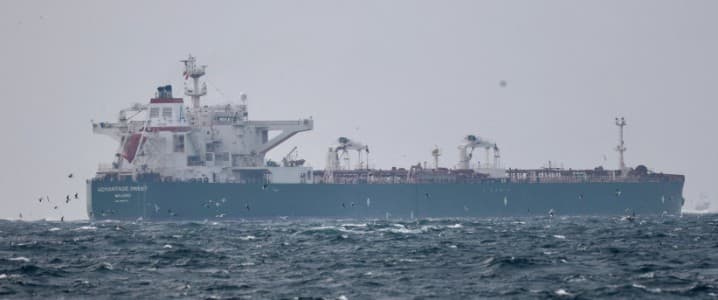According to StanChart, the latest China customs import data shows crude oil imports from Malaysia clocked in at 1.456 million barrels per day, a lot more than the country produces.
Previously, we reported that Iran’s oil exports have seen a strong rebound under the Biden administration.
Whether or not the U.S. will allow Iran to continue pumping freely will depend on who sits in the Oval Office come 2025.
Back in February, three U.S. service members were killed in Jordan, while more than 40 other soldiers were injured following a drone attack on a U.S. military base near the Syrian border. Oil markets only issued a muted response to the attack, with many analysts predicting that the administration was unlikely to cut off Iran’s key lifeline: oil exports.
Experts pointed out that Washington would allow Iranian oil to continue flowing due to the risk of squeezing supply and triggering a politically damaging spike in world oil prices.
Two months later, Washington imposed a raft of new sanctions and export controls on Iran after it launched one of the largest missile and drone attacks against Israel. According to the White House, the sanctions targeted leaders and entities connected to the Islamic Revolutionary Guard Corps (IRGC), the Iranian government’s missile and drone program and Iran’s Defense Ministry. Again, the U.S. did not try to limit Iran’s oil exports. And now commodity analysts at Standard Chartered have reported that Iranian oil exports have spiked, with Malaysian waters becoming a conduit for ship-to-ship transfers of Iranian oil.
According to StanChart, the latest China customs import data shows crude oil imports from Malaysia clocked in at 1.456 million barrels per day (mb/d) in June, the second-highest monthly average on record. The commodity experts have pointed out that Malaysia’s crude oil output is about 0.35 mb/d while exports usually average 0.2 mb/d, implying that the vast majority of the oil that China imports from Malaysia was not produced in the country.
Related: Oil Sinks as Signs of Tepid Crude Demand in Asia Multiply
According to multiple media sources, the transfers involve a dark fleet consisting of a group of aging tankers that rarely have an identifiable insurer. These transfers can be hazardous, including the danger of spills and collisions, with so many low-quality tankers massed in a narrow trade route with their transponders off. For instance, two such vessels caught fire off Singapore after a collision on 19 July.
Previously, we reported that Iran’s oil exports have seen a strong rebound under the Biden administration with the U.S. and its allies hoping to strike a new nuclear deal with Tehran after the Trump administration scuttled the Joint Comprehensive Plan of Action (JCPOA) deal of 2015. Under former President Donald Trump, Iranian oil production tumbled from 3.8 million barrels per day in early 2018 to less than 2 mb/d in late 2020; in contrast, production has surged under Biden to 3.2 mb/d.
Whether or not the U.S. will allow Iran to continue pumping freely will depend on who sits in the Oval Office come 2025. A week ago, Trump promised in his 18 July Republican National Convention speech to reduce Iranian oil exports. He said he had previously achieved this objective by linking it to trade; “I told China and other countries, if you buy from Iran, we will not let you do any business in this country and we will put tariffs on every product you do send in of 100% or more.” According to StanChart, Iranian oil is likely to play a key role in Trump’s wider China trade policy agenda. However, Tehran is likely to hope for a Kamala Harris victory since another Democrat in the highest office is likely to continue advancing Biden’s agenda.
Demand Concerns Return to Oil Markets
Oil prices have weakened significantly over the past week, with front-month Brent
falling below $80.60 per barrel (bbl) intra-day on 23 July, more than $7/bbl lower than the July 5 peak. Whereas part of the decline has been driven by weak technicals, StanChart says that a large part comes from growing trader concerns about weak demand prospects, particularly in light of softness in recent China macro data.
However, the commodity analysts have pointed out that global demand remains strong, with May demand clocking in at 102.5 mb/d–the second-highest monthly average ever. However, the May figure failed to meet the analysts’ forecast of 103 mb/d. There are notable weak spots in the latest data, the main surprise being Canada’s 360 thousand barrels per day (kb/d) (14.4%) y/y fall. Meanwhile, OECD Europe oil demand was 324 kb/d (2.4%) lower y/y, with particularly sharp falls by France and the UK while Saudi Arabia saw demand decline by 121 kb/d (3.7%) y/y.
On the gas side of things, EU inventories stood at 96.39 billion cubic meters (bcm) on 21 July, a y/y increase of 0.46 bcm and 12.18 bcm above the five-year average. The w/w build came in at 2.08 bcm, above the five-year average of 1.91 bcm but below last year’s 2.29 bcm. According to StanChart, the current injection clip is tracking to the injection season ending in late October with inventories testing maximum capacity above 116 bcm.
By Alex Kimani for Oilprice.com
More Top Reads From Oilprice.com:
Europe and China Remain the Biggest Buyers of Russian Pipeline GasMajor Automakers Returning to Gasoline Cars as EV Demand SlowsU.S. Natural Gas Market Becomes a Global LNG Force
>>> Read full article>>>
Copyright for syndicated content belongs to the linked Source : OilPrice – https://oilprice.com/Energy/Crude-Oil/Iranian-Oil-Exports-Have-Risen-Sharply-Facilitated-By-Malaysia.html
